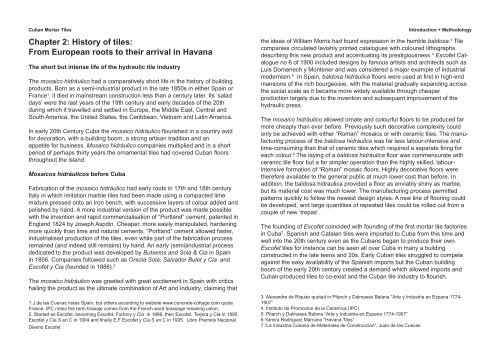Cuban Mortar Tiles - infogram.co.uk > Home
Cuban Mortar Tiles - infogram.co.uk > Home
Cuban Mortar Tiles - infogram.co.uk > Home
Create successful ePaper yourself
Turn your PDF publications into a flip-book with our unique Google optimized e-Paper software.
<strong>Cuban</strong> <strong>Mortar</strong> <strong>Tiles</strong><br />
Chapter 2: History of tiles:<br />
From European roots to their arrival in Havana<br />
The short but intense life of the hydraulic tile industry<br />
The mosai<strong>co</strong> hidráuli<strong>co</strong> had a <strong>co</strong>mparatively short life in the history of building<br />
products. Born as a semi-industrial product in the late 1850s in either Spain or<br />
France 1 , it died in mainstream <strong>co</strong>nstruction less than a century later. Its ‘salad<br />
days’ were the last years of the 19th century and early decades of the 20th<br />
during which it travelled and settled in Europe, the Middle East, Central and<br />
South America, the United States, the Caribbean, Vietnam and Latin America.<br />
In early 20th Century Cuba the mosai<strong>co</strong> hidráuli<strong>co</strong> fl ourished in a <strong>co</strong>untry avid<br />
for de<strong>co</strong>ration, with a building boom, a strong artisan tradition and an<br />
appetite for business. Mosai<strong>co</strong> hidráuli<strong>co</strong> <strong>co</strong>mpanies multiplied and in a short<br />
period of perhaps thirty years the ornamental tiles had <strong>co</strong>vered <strong>Cuban</strong> fl oors<br />
throughout the island.<br />
Mosai<strong>co</strong>s hidráuli<strong>co</strong>s before Cuba<br />
Fabrication of the mosai<strong>co</strong> hidráuli<strong>co</strong> had early roots in 17th and 18th century<br />
Italy in which imitation marble tiles had been made using a <strong>co</strong>mpacted lime<br />
mixture pressed onto an iron bench, with successive layers of <strong>co</strong>lour added and<br />
polished by hand. A more industrial version of the product was made possible<br />
with the invention and rapid <strong>co</strong>mmercialisation of “Portland” cement, patented in<br />
England 1824 by Joseph Aspdin. Cheaper, more easily manipulated, hardening<br />
more quickly than lime and natural cements, “Portland” cement allowed faster,<br />
industrialised production of the tiles, even while part of the fabrication process<br />
remained (and indeed still remains) by hand. An early (semi)industrial process<br />
dedicated to the product was developed by Butsems and Sola & Cia in Spain<br />
in 1856. Companies followed such as Orsola Sola, Salvador Bulet y Cia and<br />
Es<strong>co</strong>fet y Cia (founded in 1886). 2<br />
The mosai<strong>co</strong> hidráuli<strong>co</strong> was greeted with great excitement in Spain with critics<br />
hailing the product as the ultimate <strong>co</strong>mbination of Art and Industry, claiming that<br />
1.J.de las Cuevas notes Spain, but others ac<strong>co</strong>rding to website www.<strong>co</strong>ncrete-<strong>co</strong>ttage.<strong>co</strong>m quote<br />
France. IPC notes the term brasaje <strong>co</strong>mes from the French word brassage meaning union.<br />
2. Started as Es<strong>co</strong>fet, be<strong>co</strong>ming Es<strong>co</strong>fet, Fortuny y Cia in 1886, then Es<strong>co</strong>fet, Terjera y Cia in 1895,<br />
Es<strong>co</strong>fet y Cia S en C in 1904 and fi nally E.F Es<strong>co</strong>fet y Cia S en C in 1905. Libro Premios Nacional<br />
Diseno Es<strong>co</strong>fet<br />
Introduction + Methodology<br />
the ideas of William Morris had found expression in the humble baldosa. 3 Tile<br />
<strong>co</strong>mpanies circulated lavishly printed catalogues with <strong>co</strong>loured lithographs<br />
describing this new product and accentuating its prestigiousness. 4 Es<strong>co</strong>fet Catalogue<br />
no 6 of 1900 included designs by famous artists and architects such as<br />
Luis Domenech y Montener and was <strong>co</strong>nsidered a major example of industrial<br />
modernism. 5 In Spain, baldosa hidráulica fl oors were used at fi rst in high-end<br />
mansions of the rich bourgeoisie, with the material gradually expanding across<br />
the social scale as it became more widely available through cheaper<br />
production largely due to the invention and subsequent improvement of the<br />
hydraulic press.<br />
The mosai<strong>co</strong> hidráuli<strong>co</strong> allowed ornate and <strong>co</strong>lourful fl oors to be produced far<br />
more cheaply than ever before. Previously such de<strong>co</strong>rative <strong>co</strong>mplexity <strong>co</strong>uld<br />
only be achieved with either “Roman” mosaics or with ceramic tiles. The manufacturing<br />
process of the baldosa hidráulica was far less labour-intensive and<br />
time-<strong>co</strong>nsuming than that of ceramic tiles which required a separate fi ring for<br />
each <strong>co</strong>lour. 6 The laying of a baldosa hidráulica fl oor was <strong>co</strong>mmensurate with<br />
ceramic tile fl oor but a far simpler operation than the highly skilled, labourintensive<br />
formation of “Roman” mosaic fl oors. Highly de<strong>co</strong>rative fl oors were<br />
therefore available to the general public at much lower <strong>co</strong>st than before. In<br />
addition, the baldosa hidraulica provided a fl oor as enviably shiny as marble,<br />
but its material <strong>co</strong>st was much lower. The manufacturing process permitted<br />
patterns quickly to follow the newest design styles. A new line of fl ooring <strong>co</strong>uld<br />
be developed, and large quantities of repeated tiles <strong>co</strong>uld be rolled out from a<br />
<strong>co</strong>uple of new ‘trepas’.<br />
The founding of Es<strong>co</strong>fet <strong>co</strong>incided with founding of the fi rst mortar tile factories<br />
in Cuba 7 . Spanish and Catalan tiles were imported to Cuba from this time and<br />
well into the 20th century even as the <strong>Cuban</strong>s began to produce their own.<br />
Es<strong>co</strong>fet tiles for instance can be seen all over Cuba in many a building<br />
<strong>co</strong>nstructed in the late teens and 20s. Early <strong>Cuban</strong> tiles struggled to <strong>co</strong>mpete<br />
against the easy availability of the Spanish imports but the <strong>Cuban</strong> building<br />
boom of the early 20th century created a demand which allowed imports and<br />
<strong>Cuban</strong>-produced tiles to <strong>co</strong>-exist and the <strong>Cuban</strong> tile industry to fl ourish.<br />
3 Alexandre de Riquier quoted in Pitarch y Dalmases Balana “Arte y Industria en Espana 1774-<br />
1907”<br />
4. Instituto de Promocion de la Ceramica (IPC)<br />
5. Pitarch y Dalmases Balana “Arte y Industria en Espana 1774-1907”<br />
6.Yamira Rodriguez Marcano “Havana <strong>Tiles</strong>”<br />
7.“La Industria <strong>Cuban</strong>a de Materiales de Construcción”, Juan de las Cuevas



